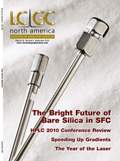Chromatography on the Front Lines of the Gulf Oil Spill
LCGC North America
The tragic Gulf Oil Spill, which has gripped the nation's collective consciousness for most of the summer, is only now beginning to turn the corner toward a long, slow recovery.
The tragic Gulf Oil Spill, which has gripped the nation's collective consciousness for most of the summer, is only now beginning to turn the corner toward a long, slow recovery. With the leak capped and a relief well being dug to provide a permanent solution to this ongoing natural disaster, it is now finally time to turn our attention to how to go about cleaning up the mess. However, before this work can get started, it is also necessary to identify just how much damage has been done and just how much mess there is to clean up.
Secondary and tertiary effects of the spill will be felt for decades to come, and one of the most critical to everyday life will be the continued contamination of the food supply in this bountiful area of the globe. A huge percentage of the world's seafood supply comes from the Gulf of Mexico, and making sure this supply remains safe and uncontaminated is one of the biggest issues facing those in charge of the clean up. And as usual, LCGC will be leading the way in bringing readers the latest cutting-edge information and research on this topic.
It is no secret to LCGC's audience of chromatographers that the lion's share of food testing will be (and is being) performed with chromatographic instrumentation and techniques, and LCGC has already hosted one gripping web seminar on this topic, with several more to follow. In addition, food safety and testing headlined an issue of the "E-Separation Solutions" newsletter last month, and this topic will be addressed again in an upcoming feature article in LCGC North America, which we hope you will find useful.
In short, as with all cutting-edge applications of chromatography, LCGC is your best resource for research and practical information, and the testing of the Gulf food supply is just one more example of this.

David Walsh

David Walsh
Editor-in-Chief David.Walsh@advanstar.com

Evaluating the Accuracy of Mass Spectrometry Spectral Databases
May 12th 2025Mass spectrometry (MS) can be effective in identifying unknown compounds, though this can be complicated if spectra is outside of known databases. Researchers aimed to test MS databases using electron–ionization (EI)–MS.

.png&w=3840&q=75)

.png&w=3840&q=75)



.png&w=3840&q=75)



.png&w=3840&q=75)











